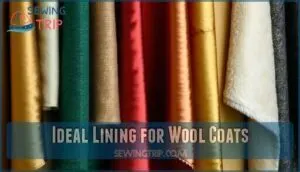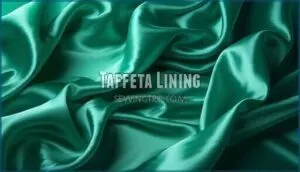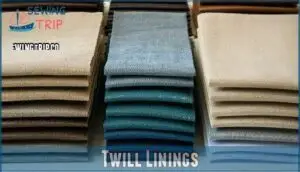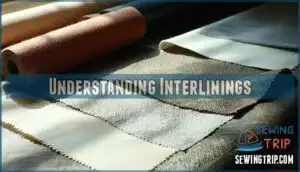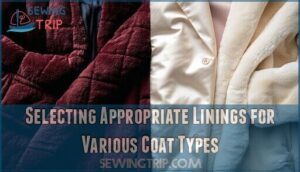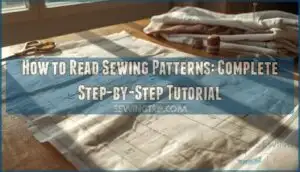This site is supported by our readers. We may earn a commission, at no cost to you, if you purchase through links.

For wool coats, Bemberg cupro offers breathability and drape, while taffeta provides structure and durability.
Cotton works well for casual jackets, and silk adds luxury to formal pieces.
Consider your climate too: flannel-backed satin brings warmth for winter coats, while lightweight cotton keeps summer blazers comfortable.
The key is balancing function with feel—your lining shouldn’t fight against your coat’s natural movement.
There’s actually a science to matching specific lining types with different coat styles and seasons.
Table Of Contents
- Key Takeaways
- Best Fabrics for Coat Lining
- Considerations in Choosing Lining Fabric
- Common Materials Used for Coat Linings
- Ideal Lining for Wool Coats
- Bemberg Cupro Linings
- Taffeta Lining
- Twill Linings
- Understanding Interlinings
- Techniques for Sewing Garments With Linings
- Selecting Appropriate Linings for Various Coat Types
- Frequently Asked Questions (FAQs)
- Conclusion
Key Takeaways
- You’ll need to match your lining’s weight to your outer fabric—heavy wool coats require substantial linings like flannel-backed satin, while lightweight jackets work best with cotton or silk that won’t add bulk.
- Choose your lining based on climate and season—Bemberg cupro offers breathability for year-round wear, cotton keeps summer blazers comfortable, and wool or fleece provides essential warmth for winter coats.
- Consider how you’ll actually use your coat when selecting lining—if you’re constantly moving, pick durable, stretchy materials that won’t restrict motion or tear easily under stress.
- Don’t overlook fabric compatibility for care and performance—your lining should survive the same cleaning routine as your outer fabric and complement its natural drape without fighting against movement.
Best Fabrics for Coat Lining
When selecting coat lining fabrics, you’ll find three main categories that make or break your project’s success.
Natural fibers like silk deliver luxurious smoothness, while cotton provides breathability and wool offers warmth. Artificial options such as cupro mimic silk’s feel with superior durability expectations.
Synthetic materials—polyester, viscose, and rayon—bring practical performance where fabric drape matters most.
Your seasonal fabric choice affects comfort substantially. Considering various lining options can greatly enhance the final product. Lining fabric weight impacts how your coat moves and feels. The best lining material balances breathability and comfort with your specific needs and climate requirements.
Considerations in Choosing Lining Fabric
When you’re picking the perfect lining for your coat, you’ll need to balance several key factors that work together like ingredients in your grandmother’s secret recipe.
Perfect lining transforms ordinary coats into custom masterpieces that move with effortless grace.
You’ll want to take into account the fabric’s weight, breathability, and durability alongside your coat’s intended use, the season you’ll wear it, and how the lining’s characteristics match your outer fabric’s needs.
Fabric Characteristics
When choosing coat lining, fabric characteristics make or break your final product.
These properties determine whether you’ll have a coat that moves gracefully or fights you at every turn.
- Weight and Texture – Heavy linings support structured coats, while lightweight options enhance drape
- Breathability Factors – Natural fibers like cotton allow airflow, synthetic materials may trap heat
- Durability Aspects – Polyester resists wear, silk tears easily with frequent use
- Opacity Impact – Sheer linings show through light fabrics
- Drape and Flow – Slippery surfaces reduce friction, making coats easier to wear
Selecting the appropriate lining involves considering specific weight requirements.
Garment Needs
Understanding your coat’s specific needs is like finding the perfect dance partner – everything must work in harmony.
Your lining choice should align with how you’ll actually use your coat, not just how it looks hanging in your closet.
Consider these four essential factors when choosing coat lining:
- Climate Impact: Hot summers demand breathable fabrics like cotton or silk, while freezing winters call for insulating materials such as flannel-backed satin or wool blends.
- Activity Level: If you’re constantly on the move, select durable, stretchy linings that won’t restrict your range of motion or tear easily.
- Intended Use: A formal business coat requires different lining fabric properties than a casual weekend jacket – think luxury versus practicality.
- Personal Style: Your hidden lining reflects your personality, whether that’s bold patterns or classic elegance.
Smart lining fabric types selection transforms ordinary coats into extraordinary garments that truly serve your lifestyle.
Selecting optimal coat linings can substantially impact garment longevity.
Fabric Types
Each fabric type brings unique benefits to your coat lining game.
Natural Fibers like silk and cotton offer breathability and comfort, while Synthetic Blends deliver durability and easy care.
Performance Fabrics excel in moisture-wicking for active wear.
Novelty Linings and Printed Linings add personality—think bold florals hiding inside your winter coat.
Understanding lining fabric properties helps you match function with style perfectly, considering factors like high breathability and wrinkle resistance to create the perfect luxury coats.
Common Materials Used for Coat Linings
When you’re picking coat lining fabrics, the material world opens up with exciting possibilities.
Your fabric choice shapes everything from comfort to longevity, making this decision vital for any successful project.
Here’s what savvy sewists reach for most often:
- Cotton delivers Natural Fiber Benefits through breathability and easy care
- Polyester offers Synthetic Fiber Benefits with excellent Lining Fabric Durability
- Viscose provides silky smoothness at reasonable Lining Material Cost
- Bemberg Cupro combines luxury with performance for premium projects
- Blended Fabric Options like poly-cotton merge the best of both worlds
Each lining fabrics choice tells your coat’s comfort story. For winter warmth, consider that wool offers breathability as a coat fabric.
Ideal Lining for Wool Coats
Why settle for mediocre when your wool coat deserves a champion lining? The perfect match transforms your outer layer from good to exceptional, creating harmony between function and comfort.
Your wool coat’s lining needs careful consideration across multiple factors:
- Warmth Factor – Kasha satin delivers cozy flannel-backed comfort without creating bulk
- Breathability Needs – Bemberg Cupro allows air circulation while maintaining elegance
- Durability Concerns – Heavy viscose twill withstands daily wear like a champ
Drape Compatibility matters too. Viscose creates that coveted couture feel, while polyester offers practical sliding ease for busy mornings. Cost Analysis reveals fleece and quilted options provide budget-friendly warmth for winter warriors.
Your lining fabric warmth directly impacts coat performance. Warm lining fabrics like fleece, fake fur, or Sherpa transform wool coats into portable comfort zones. Remember, this isn’t just about covering seams—it’s about engineering your perfect wearing experience.
Bemberg Cupro Linings
Move beyond basic wool linings to discover Bemberg Cupro—the premium choice that’ll transform your coat’s interior. This Japanese-made fabric from cotton linter offers unmatched breathability and durability without silk’s hefty price tag.
Bemberg Cupro combines luxury and practicality, delivering silky breathability and eco-friendly elegance to your coat’s interior.
You’ll love its anti-static properties that prevent clinging, plus its completely biodegradable nature supports Bemberg Sustainability goals. Its production utilizes recycled cotton linter for sustainability.
| Feature | Bemberg Cupro | Traditional Polyester | Silk |
|---|---|---|---|
| Breathability | Exceptional | Poor | Good |
| Durability | High | Very High | Medium |
| Cost | Moderate | Low | High |
| Eco-Impact | Biodegradable | Non-degradable | Natural |
| Drape Quality | Excellent | Fair | Superior |
Whether you’re lining wool coats or lightweight jackets, Cupro Durability guarantees long-lasting performance across diverse Lining Applications.
Taffeta Lining
While cupro offers breathability, you’ll discover that taffeta brings something entirely different to your coat’s interior.
Taffeta lining transforms your garment with its signature crisp texture and luminescent sheen. This synthetic fiber marvel glides smoothly against your skin, making coat removal effortless after long days.
Taffeta Properties include exceptional wrinkle resistance and mechanical stretch, while Taffeta Durability guarantees your investment lasts through countless wears. The tight weave creates structure without bulk.
- Taffeta Textures range from silky-smooth polyester to moisture-resistant blends
- Taffeta Colors span brilliant hues from champagne to emerald green
- Taffeta Cost remains budget-friendly compared to silk alternatives
Available 54 inches wide, this lining fabric texture offers versatility for any coat style. Whether you’re crafting evening wear or everyday outerwear, taffeta’s anti-static properties and lustrous finish elevate your garment’s interior sophistication.
Twill Linings
While taffeta brings elegance, twill linings pack serious punch with their signature diagonal weave pattern. This weave variations create exceptional twill durability that outperforms plain weaves by miles.
You’ll find durable lining fabrics like 100% acetate twill offering silky smoothness while staying perspiration-proof. Cotton twill brings natural breathability and sturdiness that’s hard to beat. The lining fabric texture feels substantial yet comfortable against your skin.
Lining fabric weight matters here—heavy viscose twill gives that custom feel tailors love, while lighter options work perfectly for everyday jackets. Twill applications span from casual blazers to luxury overcoats.
The diagonal construction adds strength where you need it most, reducing wear and tear. Twill cost varies by fiber content, but you’re investing in longevity. These fabrics slide smoothly over clothing, making your coat easier to slip on and off. With over 100 color options available, you’ll find the perfect match for any project.
Understanding Interlinings
Beyond choosing the perfect twill for your coat lining, you’ll need to understand interlinings—the secret layer that transforms good coats into great ones.
Interlinings work like a coat’s backbone, sitting between your outer fabric and lining to provide Structure Enhancement and Warmth Provision.
Think of them as your garment’s personal trainer, keeping everything in perfect shape.
You’ve got two main Interlining Types to examine. Fusible interlining bonds with heat, creating permanent support that’s perfect for crisp, custom-made looks. Sew-in interlining gets stitched directly into place, offering flexibility for lightweight fabrics that can’t handle high heat.
Fabric Compatibility matters here—heavy wool coats need substantial interlining, while summer jackets require whisper-light options. Considering the plain weave characteristics can inform your choice of interlining. The right choice dramatically improves Coat Performance, preventing sagging and maintaining that fresh-from-the-tailor appearance for years.
Techniques for Sewing Garments With Linings
Now that you understand interlinings, let’s master the actual sewing process. Getting your coat lining right isn’t rocket science, but it does require the right techniques.
Start with precision cutting—use pattern weights to prevent slippery fabrics from shifting while you work. Mark all seam points clearly before you begin stitching.
Choose your attachment approach based on your skill level:
- Bagging Method: Sew lining and outer fabric together, then turn right-side out through an opening
- Traditional Lining Attachment Methods: Secure key areas like necklines and armholes first
- Understitching Techniques: Stitch lining close to seams, preventing shifting and rolling
Remember, proper seam finishing makes all the difference. Press seams open and trim where needed—your future self will thank you.
Selecting Appropriate Linings for Various Coat Types
You’ll need to match your lining choice to your coat’s specific purpose, weight, and the season you’ll wear it most.
Think of it like choosing the right underwear for different outfits—a heavy wool winter coat needs substantial, warm lining, while your lightweight spring jacket works best with breathable, thin fabric that won’t add bulk.
Fabric Weight Considerations
Getting your fabric weight right is like finding the perfect dance partner—everything flows better when they’re in sync.
Your lining fabrics should match or weigh less than your coat’s outer material.
Lightweight linings (100-170 GSM) work great for activewear, while heavyweight options (340+ GSM) provide coat structure for winter wear.
Weight compatibility guarantees proper drape impact without bulk.
Seasonal Suitability
Smart seasonal choices make all the difference when selecting coat linings. Your climate and activity levels should guide every decision, ensuring comfort year-round.
- Winter linings: Choose wool, fleece, or quilted materials for superior winter insulation. These fabrics trap warm air while maintaining breathability, perfect for cold-weather coats and heavy outerwear.
- Summer linings: Opt for cotton, viscose, or lightweight silk that prioritizes fabric breathability. Summer coats need materials that won’t trap heat, keeping you cool during warmer months.
- Transitional seasons: Select cupro or silk-wool blends that adapt to changing temperatures. These versatile options work beautifully for spring and fall coats when weather can’t make up its mind.
Climate considerations trump everything else—your lining should complement both the season and your lifestyle.
Matching Linings to Outer Fabrics
Harmony between lining fabrics and outer fabrics creates coat perfection.
You’ll need weight compatibility – your lining should never outweigh the shell fabric.
Focus on drape consideration for smooth movement and texture harmony for comfort.
Care alignment guarantees both fabrics survive the same washing routine.
Color coordination offers seamless blending or striking contrast.
Smart fabric matching through careful fabric selection guarantees fabric compatibility that looks professional and feels luxurious every time you wear it.
Frequently Asked Questions (FAQs)
What is the best fabric for coat lining?
Choosing the perfect coat lining isn’t rocket science!
You’ll want Bemberg cupro for breathability and luxury, or go with silk for smoothness.
Cotton works great for everyday comfort, while polyester offers durability.
What is the warmest lining for a coat?
Wool flannel and fleece linings provide the warmest options for your coat.
You’ll stay toasty with down-filled quilted linings or Thinsulate insulation.
For luxury warmth, try cashmere or wool-backed satin that breathes while trapping heat.
What is the best lining for a puffer jacket?
You’ll want lightweight, breathable polyester or nylon lining for your puffer jacket.
These synthetic materials won’t compete with the down insulation while providing smooth, moisture-wicking comfort that moves with you during active wear.
What color should lining fabric be?
Ever wondered why some coats feel like wearing a work of art?
You’ll want your lining color to either match your coat’s outer fabric perfectly or create stunning contrast with bold, dark shades that surprise and delight.
What should you consider when choosing lining fabric?
Consider the coat’s weight, season, and intended use first.
Match lining weight to outer fabric, prioritize breathability for active wear, choose warmth for winter, and make certain care instructions align perfectly.
What material are coats lined with?
Coats are lined with countless materials.
You’ll find silk, polyester, cotton, rayon, acetate, and Bemberg cupro most commonly.
Satin adds luxury, while taffeta provides structure.
Choose based on your coat’s weight and intended use.
What lining to use on a wool coat?
You’ll want Bemberg cupro for breathable luxury, or flannel-backed satin for extra warmth.
Match the lining’s weight to your wool’s thickness.
Skip polyester—it’ll make you sweat like you’re wearing a plastic bag.
Whats the best lining for a summer coat?
Need a summer coat that won’t turn you into a walking sauna?
Choose lightweight, breathable linings like cotton voile, silk, or viscose.
These materials let air flow freely while keeping you comfortable in warm weather.
Do I need to wash my coat lining separately?
You don’t need to wash coat linings separately.
Most coats should be dry cleaned as a complete unit, since the lining and outer fabric are sewn together and have matching care requirements.
Whats the warmest lining for a coat?
Wool-based linings like Kasha satin or fleece offer exceptional warmth for winter coats.
You’ll also find Thinsulate provides excellent insulation while staying lightweight.
These materials trap body heat effectively, keeping you cozy during harsh weather conditions, with exceptional warmth being a key benefit.
Conclusion
Professional tailors report that 80% of coat comfort issues stem from poorly matched linings—a statistic that highlights why selecting lining fabrics for coats matters so much.
You’ve now got the tools to choose wisely: match weights, consider your climate, and think about how you’ll move.
Whether you’re working with wool, cotton, or silk, remember that great lining disappears into the background while bad lining announces itself with every step.
Your coat’s success depends on this hidden hero.
- https://www.seamwork.com/articles/one-pattern-three-linings
- https://www.rampleyandco.com/blogs/the-journal/complete-guide-suit-jacket-linings
- https://corefabricstore.com/products/bemberg-cupro-lining?srsltid=AfmBOorBkDMY_ZeeF2KWKvvDUxg_Yofa0iwCW4-e9J7wgA8dZ7zL_yMs
- https://marcytilton.com/products/black-cat-cupro-lining-woven?srsltid=AfmBOopdNUJDiOMTJY9kKoQWPvKnlx8y9zasHoO1VUdri2Rr3XtS1-W2
- https://www.moodfabrics.com/fashion-fabrics/linings/bemberg


